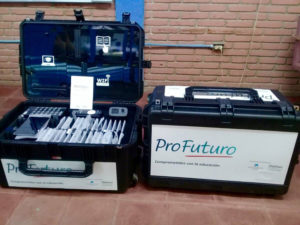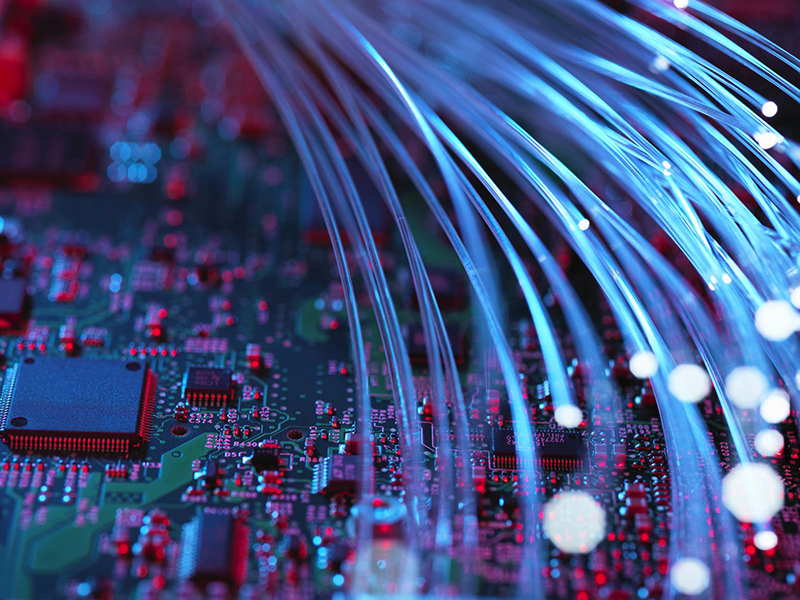*This article is an abridged and adapted version of the article “Designing an Intelligent Virtual Educational System to Improve the Efficiency of Primary Education in Developing Countries”, published in Electronics Magazine.

If we had been told a few years ago that we would see a robot helping surgeons to operate with greater skill or that an algorithm would help to diagnose diseases such as cancer or Alzheimer’s with almost mathematical precision, we would have smiled in disbelief. However, these realities have leapt from science fiction into the headlines of media outlets. Practically every day, we get a glimpse of the almost never-ending ability of these technologies to transform our lives.
The education sector wasn’t one of the first to embrace them, but nowadays, no one puts into question their importance and that of applications such as artificial intelligence and data science in the transformation of the sector towards better and more equitable education. For example, they can help us to predict and anticipate drop-outs from school, they can personalise students’ educational pathways, monitor their follow-up and predict their results, they can recommend next steps and they can help teachers by providing them with tools to support the above personalised training.
As an institution that seeks to transform education and bring it to vulnerable environments by using technology, artificial intelligence and data are critical to the success of the mission of ProFuturo, whose data-driven philosophy enables the entire organisation to make better decisions based on the data it collects and processes in all the environments and countries in which it operates.
The incorporation of technology into virtual education is leading educational institutions to demand a migration from the current learning management system to a smart virtual education system, seeking greater benefits by means of the exploitation of the data generated by the students in their daily activity.
In this article, we explain how one of these systems, the ProFuturo one, has been designed from this new standpoint, which capitalises on the new analytical functions provided by new technologies such as artificial intelligence, data intelligence (or big data), educational data mining techniques and analytical learning.
As an institution that aims to transform education and bring it to vulnerable environments using technology, artificial intelligence and data are critical to the success of ProFuturo’s mission.
A few basic concepts
Before we begin, we’ll explain a few basic concepts that will help us to understand how these systems are operated and designed.
Data intelligence and educational data mining
Data intelligence (or big data) is a term used to describe extremely large and complex datasets that are difficult to manage and analyse using traditional tools. Their management and analysis requires advanced technologies, including data mining, which involves the process of analysing large datasets to identify useful patterns, relationships and trends. The application of data mining techniques to the vast amount of data stemming from students’ virtual interactions has led to the creation of the term “Educational Data Mining”, consisting of the search for patterns or rules of inference in stored records.
Analytical learning or learning analytics
Analytical learning is a discipline that combines data analytics and machine learning techniques to improve the performance of learning systems. The main goal of analytical learning is to take advantage of the data generated during the learning process to acquire a better understanding of how students learn and how learning systems can be improved. The above is achieved by means of the collection and analysis of data on the use of learning systems, student performance and the interaction between students and materials, among other factors.
Analytical learning can help to identify patterns and trends in the students’ performance, thus providing valuable information to improve the effectiveness and efficiency of learning programmes. It can also prove useful in personalising the learning experiences of each of the students and adapting it to their individual needs.
Artificial intelligence
The latest technology to enter the field of education is artificial intelligence, through its predictive algorithms implemented with machine learning techniques that allow the incorporation of automated processes to assist users in their decision-making processes. As they operate, the automated processes sort the records into relationships and related activities in order to detect similar personal patterns that can then be extrapolated to similar learners.
The incorporation of technology in education induces educational institutions to demand a migration from the current learning management system to an intelligent virtual education system.
ProFuturo’s data and platform
ProFuturo’s educational proposal uses a proprietary platform with customisable educational resources, which are adapted to the local learning context to serve primary schools in more than 40 countries with low levels of socio-economic development and territories with low school enrolment rates.

Together with the learning platform, the different educational centres receive basic technological equipment that allows them to gain access to the platform’s contents, including a server, a router, a laptop, tablets and so on. The aim of the interaction is for the students to access the platform and play an active role in the learning process by means of the learning by doing principle. This digital ecosystem allows teachers to continuously assess their students and personalise their teaching in keeping with each one’s progress.
Data play a key role in the design of a smart virtual education system by enabling deeper understanding of how the students learn and how the system can be improved to deliver a more effective learning experience.
In ProFuturo’s smart virtual education system, the data come from each of the educational centres that belong to the educational project, which means that the system obtains a heterogeneous set of data sources. The data are currently collected from 40 countries in Latin America, Asia and Africa.
Data cleansing
The smart virtual education system thus captures data from all these sources and then subjects them to a transformation process to provide reliable ones. This process unfolds in two stages, a data cleansing stage and a data conversion stage, with the aim of presenting the data in a format to allow their analysis by the smart system’s algorithms.
Selection of analytical tools
Following the data cleansing and conversion process, the data are in a format suitable for the future application of algorithms and analytical tools. The wide range of potential techniques that can be used include predictive models capable of forecasting results by applying statistical techniques to the data, machine learning models that enable academic institutions to make decisions based on knowledge rather than intuition, rules of association that can identify patterns (e.g. those followed by a student in his/her learning process) and fuzzy logic techniques, which can be used to make recommendations that can be adapted to the student’s profile to help to improve his/her learning.
In ProFuturo’s intelligent virtual education system, data comes from each of the project’s schools in 40 countries in Latin America, Asia and Africa.
What should be incorporated into the design of a smart virtual education system?
In addition to the automatic procedures inherent to a smart system, such as artificial intelligence algorithms and machine learning techniques, the design of a smart education system must also incorporate the requirements that education demands of the virtual environment. In order to incorporate them properly, our smart education system is divided into four basic sub-systems:
- Data storage This subsystem is responsible for capturing and storing the data transferred from the different countries and cleaning and converting them into quality-assured data. Its aim is to supply reliable data to the following subsystem: the analytical subsystem.
- Analytical data processing Once the information collection and storage process has been completed and the reliability of the data has been guaranteed, the smart system analytically processes all the information by using data mining techniques to facilitate machine learning.
- Supervision and monitoring of the process The purpose of these monitoring controls is to obtain data to assess the quality of the smart system and thus implement measures to improve the aspects of the teaching that aren’t evolving as the institutions would wish. The aspects monitored in this subsystem include teachers’ digital skills, use of digital resources, connection times and connection failures. The results of this monitoring will generate results that will be interpreted by the smart system and sent to the last subsystem: the recommendation subsystem.
- Recommendation subsystem This is responsible for transmitting the recommendations made by the smart virtual education system to teachers, students and educational centres so that they can be applied in new iterations of the teaching-learning process. This subsystem makes the recommendations upon the basis of the data obtained in the monitoring system. The recommender system will thus recommend to a user educational resources with similar content to that of others he/she has already used or use educational resources that one person has used to recommend them to another person who has previously had access to the same resources.
ProFuturo’s intelligent education system is structured in four subsystems: data storage, analytical data processing, monitoring and tracking, and recommendation subsystem.
Pending challenges
Although these systems are here to stay and giving new impetus to education as we know it, the incorporation of artificial intelligence and data science techniques into learning analytics processes is still at an early stage, with some challenges still to be overcome:
Research Although many of these techniques are already working properly, there’s still some research to be done. For example, in terms of systems, there’s still room for improvement, such as the creation of new forms of monitoring to improve the tracking of the smart system, the implementation of innovative visualisations and improvements to the effectiveness of the recommendation systems; there’s also room for research into the implementation of new forms of evaluation allowing students to evaluate themselves, and, finally, in response to the needs of the educational institutions, the research needs to focus on better integration of these smart systems into the different existing learning platforms, in order to reuse the large number of learning resources that have been developed.
Ethics Ethics is a crucial aspect of smart virtual education systems and the appropriate measures must be taken to ensure that ethical and privacy standards are fulfilled. Smart virtual education systems collect and store a large amount of information on students, such as their academic histories, learning preferences and study habits. This information may be valuable when it comes to improving education, but it can also be used for improper purposes if adequate measures are not taken to protect it. It’s therefore important for the developers of smart virtual education systems to adopt ethical practices and comply with the international privacy and data protection standards. It’s also important for the students and parents to understand how the information is being used and exert control over it.
Smart education systems: allies in combating inequality
According to Wayne Holmes, a UNESCO expert in education and AI, “equity in education means recognising that having the same opportunities is not enough for all young people to reach their full potential. The most vulnerable children need additional and faster support from us”. This is why it’s important to be precise in analysing the situation and quick but accurate in implementing the solutions. In this task, a well-designed smart education system can be our greatest ally in addressing educational inequality and giving all students the chance to receive high-quality education.






